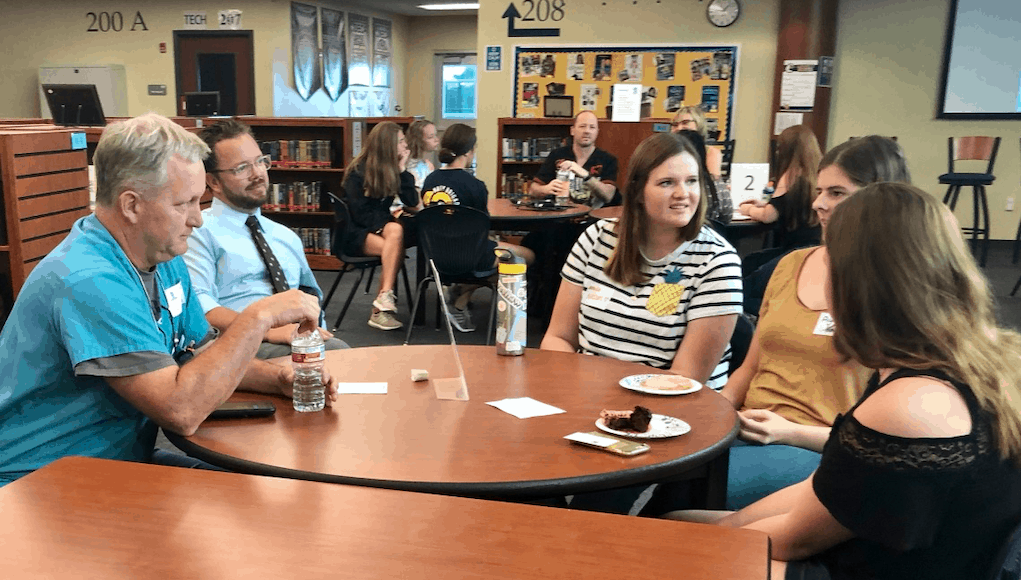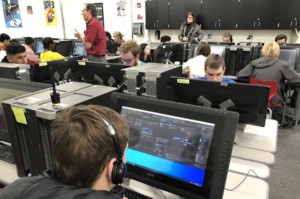Kansas City High Schools Add Real-World Learning

The good news is that more young people are graduating from high school than ever. The bad news? High school is often less relevant to them and their futures than ever.
The largest effort to make high school more valuable—to young people and their communities— is underway in the six-county two-state Kansas City metro area.
About 60 schools in 15 districts from Kansas and Missouri are spending this school year investigating ways they can make high school more valuable to young people by incorporating more real-world learning. The goal is to add more powerful and relevant learning experiences and to help youth capture and communicate those experiences with credentials and assets recognized by higher education and employers.
Real-World Learning for All Students
In a monthly meeting with regional superintendents, Aaron North, vice president of education at the Ewing Marion Kauffman Foundation, noted that we as a country need to bring an equal amount of intentionality and investment to non-degree career pathways as we do to college pathways. Only a third of all Americans have a four-year college degree and only half of all jobs requiring a postsecondary credential require that to be a four-year degree. Most people end up finding their way to work outside the college path and we can do more to support the opportunities available to those millions of individuals.
North explained that college degrees are important and should continue to be options for all students, particularly for students who are traditionally underrepresented or overlooked in postsecondary education. College graduation should not be the only option of which students are aware or the only one getting dollars and attention from foundations, school systems, and government. Getting or making a good job is one important end of many education pathways and there are multiple ways to see that come to fruition.
Research started by Susan Wally, PREP KC, and continued by Donna McDaniel, an educator in residence at the Kauffman Foundation, identified four types of assets valued by employers and higher education:
- Work experiences: internships and client-connected projects
- College credit: at least three classes
- Industry recognized credentials
- Entrepreneurial experiences: starting a business or launching an initiative
About a quarter of regional graduates leave school with one of the “market value assets.” The 2030 goal of the Kauffman-sponsored initiative is for all Kansas City area graduates to earn at least one of these assets.
Design teams from each of the districts—each incorporating diverse stakeholders including employers, parents, civic leaders and educators—are working with their high schools to identify opportunities to expand access to college credit classes, internship programs, and credentialed pathways. School teams are also looking for ways to connect more projects to business and civic partners.
Entrepreneurial experience is a new category for most schools. Some schools are considering adding classes and afterschool opportunities to support youth efforts at starting a business or launching an initiative.
Many schools are considering ways they can improve guidance to support good decision-making and postsecondary planning.
Some Kansas City area schools are planning new academies that will bundle several strategies including college credit and high tech work experience with a business partner (often called P-Tech).
Design teams get together monthly to learn from each other and coordinate efforts, including internship requests with big employers like Sprint and Cerner.
Schools will have the opportunity to petition their peers to add new assets. Like the first four categories, these new assets will need to 1) be work that is valued by industry and/or post-secondary institutions, 2) include performance that is evaluated by multiple stakeholders including some outside education, 3) encourage student growth in multiple dimensions, and build learner social capital.
Supporting Real-World Learning
Planning grants of about $75,000 were made to the 15 districts. Another cohort of districts is getting ready to follow in a second wave. All 45 districts in the six counties serving over 100,000 students are part of the dialog and will benefit from the infrastructure and models being developed. The mobilization, coordination and collaboration of so many school districts across multiple counties and two states is remarkable.
The Kauffman Foundation is working with regional initiatives like the Greater Kansas City Chamber and KC Rising, as well as a number of local employers in a collaborative effort to align initiatives around common goals and activities. The convergence of this ‘business-to-education’ (B2E) component will be broader business engagement, more equitable student access, a data hub—information about local businesses and tracking student progress during and after high school—and a robust community of practice among educators from participating districts that can continually evaluate and evolve what is offered to students and the Kansas City region.
The massive regional mobilization to make high school more valuable signals that the foundation’s Real World Learning initiative is both timely and attractive. The framework is specific enough to support goal setting but flexible enough for schools to pick areas of focus. Some districts will combine several improvement efforts, while others will launch innovative new schools.
The aggregate result is likely to be that in a few years, nearly all local students will have more valuable high school experiences—and a few years after that, Kansas City will be an even more vibrant place to live, learn, and earn.
For more see:
- Time to Rethink Education
- Rethink ED: 3 Hallmarks of the Future of Learning
- Project-Based Learning Connects Real World With Deep Impact
Stay in-the-know with innovations in learning by signing up for the weekly Smart Update.
This post includes mentions of a Getting Smart partner. For a full list of partners, affiliate organizations and all other disclosures, please see our Partner page.
This post was originally published on Forbes.




0 Comments
Leave a Comment
Your email address will not be published. All fields are required.